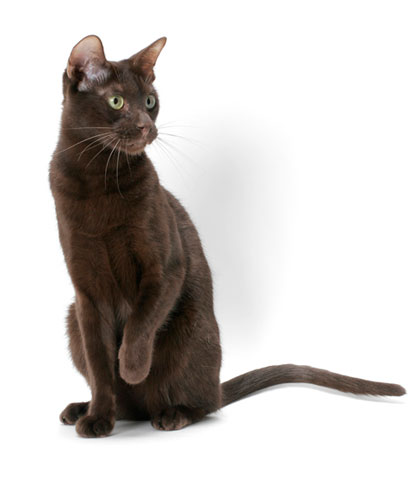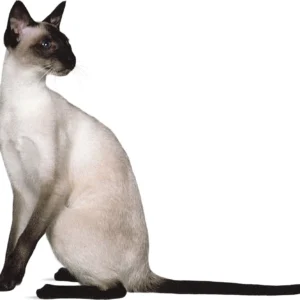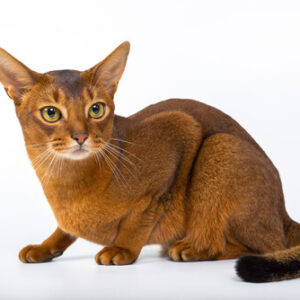Havana Brown Cat Breed:
Active: The Havana Brown is moderately active. They are playful and affectionate, seeking the attention of their companions.
Size: Their bodies are medium in size and athletic in muscle tone, usually weighing about 6 – 10 pounds.
Characteristics: Havana Brown cats have a unique and beautiful appearance. If you have ever looked into the eyes of a Havana Brown, you are probably still mesmerized by their striking green gaze. They have long faces with a very distinct muzzle that is often described as “corn cob shaped.” Perched on top of their heads are large, pointed ears that give them the appearance of constant alertness. With their big bright eyes and large pointed ears it may look as though your Havana Brown has had one too many cups of coffee all the time!
Temperament: They are loving companions that thrive on human interaction. Not only do they thrive on it, but they require regular interaction and play and will be sure to demand it. But, while they love to interact and play, they certainly love to relax and cuddle up. The Havana Brown is a pleasure to be with as they love to play and love companionship and relaxation as well. They seem to share an equal love for playing and napping. They are a curious breed and love to touch things and explore with their paws. They enjoy a good game of fetch and will want to be with you wherever you are in the house. If you want a cat that is low-maintenance and can be left alone a lot, this is not the cat for you. Havana Brown cats love attention and affection. They are highly intelligent, love to interact and when they finally tire themselves, love to curl up on your lap and take a nap. And you will enjoy having them on your lap because you will get to stroke their beautifully soft chocolate brown coat. They are a true joy as companions and many fanciers say once you have experienced spending time with a Havana Brown, you will want to enjoy the breed for life.
Care: The coat of the Havana Brown does not shed very much, so weekly brushing will keep the coat looking nice. Additionally, nail trimming and ear cleaning as needed will help keep your Havana Brown looking lovely.
Coat: Their luxurious, mink-like coat is even-colored chocolate brown. But, there are some lilac-colored Havana Browns that are allowed. Their chocolate-brown coat along with their striking green eyes will entrance you.
Origin: The Havana Brown cat breed likely dates back centuries, but the breed was not formally established until the 1900s. The Havana Brown is part of the Siamese family and, for many years, was considered to be Siamese but with a brown coat and has been described as a “chocolate-covered Siamese.” The breed was formally developed during the 1950s and has been a popular breed for fanciers ever since. Havana Browns are a man-made breed that English breeders worked on to promote the look of the beautiful chocolate brown coat. The first cat to be called a Havana Brown was a cat named Elmtower Bronze Idol. It is fitting that a cat with such a big name would be the beginning of a breed. Elmtower came about because of a breeding program that crossed Siamese, domestic shorthairs and Russian Blue cats.
Both the seal point Siamese and the black cat carried recessive brown genes that contributed to Elmtower’s chocolate brown color. In 1958 the Governing Council of the Cat Fancy allowed the breed to compete in the Championship competition. The breed competed under the name Chestnut Brown Foreign but was later changed to Havana Brown. The Havana cat breed came to the United States in the mid-1950s. So, how does a cat that has origins in Siam, that was bred in the United Kingdom and then traveled to the United States have the name Havana Brown? The cat is not from Cuba but some say that it may have been named that because of the coat’s resemblance to a Cuban cigar color. But, while this may very well be the true story, another story exists as well.
Some say the Havana Brown cat breed is named after a rabbit breed that has the same coloring. The breed was granted championship status and the breed gene pool was then closed in the 1970s. While the breed is popular, the breed’s numbers diminished over the years and by the 1990s, there was concern among fanciers for the breed. In 1997 the CFA decided to allow outcrossings with certain oriental shorthairs and, in 1998 a breeding program began to help support the Havana Brown cat breed to ensure the breed’s existence is protected.
Be the first to review “Havana Brown Cat” Cancel reply
Related products
kittens
kittens
kittens
kittens
kittens
kittens
kittens
kittens





















Reviews
There are no reviews yet.